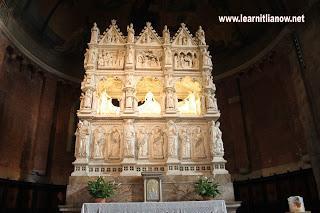
the tomb of Saint. Augustine
Pavia is a town in the northern Italy, rich in history and in traditions. The presence of many churches on its territory testify that thiswas a place of worship but also the seat of the ecclesiastical power at the same time of the governor of Visconti. Wandering around the cobbled streets of the down town we found a jewel of art and history: The Basilica of San Pietro in Ciel d'oro. One of the first presence of this church dates back to 640 AD: the present church - with its Lombard Romanesque - dates from the twelfth century and it was consecrated in 1132. It was mentioned by Dante, by Petrarch and by Boccaccio: the name “ golden sky0 cielo d’oro” recalled the golden shades of the ceiling.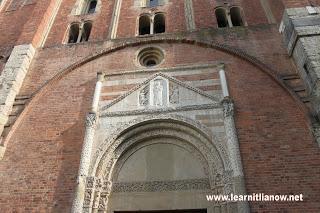
Tha facade of the churc
The facade is made with the gray sandstone and the brick floors.
The main entrance is made with the sandstone and it is surmounted by a bas-reliefdepicting an angel and two men of prayer.
The interior consists of three naves separated by two rows of five pillars made with sandstone with decorations on the capitals. Unfortunately, much of the artistic works of the time are no longer present except for a twelfth-century mosaic in the floor of the apse of the right aisle.
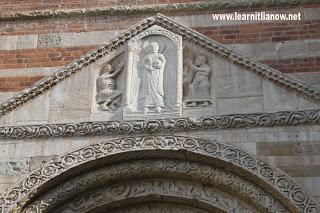
A particular of a facade
The left aisle has the frescoes of the fifteenth century that are typical of the Lombard school ans some other of sixteenth century. The church has a special aura of mysticism because here the tomb of St. Augustine is preserved: he was not only a leading figure in the ecclesiastical sphere, but was also a great philosopher. The tomb is made with white marble dates back to the fourteenth century and it is decorated with statues and bas-reliefs depicting episodes from the life of the saint. It looks like a magical place, surrounded by lights that have the flag of every country in the world. Under the tomb of St. Augustine you find the crypt, supported by 24 columns: there is a well of the unknown origin remote but it is known as Blessed.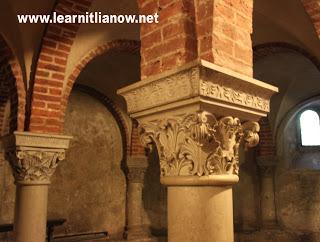
the crypt of Basilica di san Pietro in Ciel d'oro
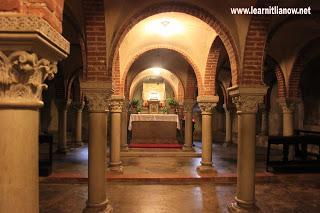
the crypt of Basilica di san Pietro in Ciel d'oro |
You should definitely see the sacristy with the two side altars: a majestic Renaissance room with the vaults full of grotesque decorations which dates back to the second half of the sixteenth century. The remarkable canvas of 1599 represented St. Augustine talks with S. Jerome. The two marble altars were made by the sculptorScappola in the twentieth century. Art and mysticism, culture and religion: in this place the aura of a great philosopher of the past waft in the air, while his mortal remains stay in a secular sleep.
You can endorse the basilica from 7 to 12 and from 15 to 19 Piazza S. Pietro in Cielo d'oro 2 Pavia www.santagostinopavia.it
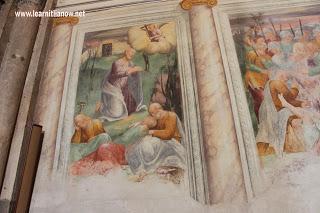
The frescoes on the left side of the churc
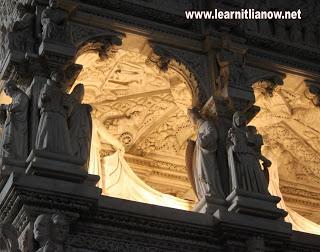
the tomb of saint Augustine
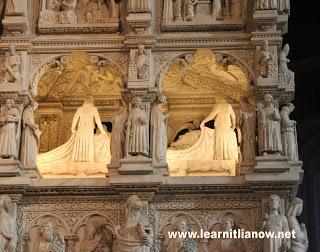
the tomb of saint Augustine- one side
Pavia è una cittadina nel nord Italia ricca di storia e di tradizioni. La numerosa presenza di chiese sul suo territorio testimonia come fu luogo di culto ma anche sede del potere ecclesiastico che si affiancava a quello Visconteo. Gironzolando per le vie acciottolate del centro abbiamo scoperto un gioiello dell’arte e della storia: La basilica di San Pietro in Ciel d’oro. Una delle prime testimonianze di questa basilica risale al 640 d.C.: l’attuale basilica, con le sue forme romanico lombarde, risale al XII secolo e fu consacrata nel 1132. Fu citata da Dante , da Petrarca e da Boccacio: Il nome “ciel d’oro” richiamava le tinte oro del soffitto.La facciata è in arenaria grigia e mattone in cotto. Il portone è in pietra arenaria ed è sormontato da un bassorilievoche raffiguraun angelo edue persone oranti. L’interno è composto da tre navate divise da due file di cinque pilastri in arenaria con decorazioni sui capitelli . purtroppo gran parte della opere artistiche del tempo non sono più presenti tranne che per un mosaico del XII secolo nel pavimento dell’abside della navata destra. La navata sinistra è riuscita a conservare degli affreschi del quattrocento tipici della scuola lombarda che si affiancano ad altri del Cinquecento. La chiesa ha una speciale aurea di misticismo perchè in essa è conservata la tomba di Sant’Agostino che non solo fu un personaggio di spicco per l’ambito ecclesiastico ma fu anche un grande filosofo. La tomba è in marmo bianco risale al Trecento ed è ornata da statue e bassorilievi: sono rappresentati episodi della vita del Santo. Sembra un luogo magico,circondato da lumi che hanno al bandiera di tutti i paesi del mondo. Sotto la tomba di Sant’Agostino troverete la cripta, sorretta da 24 colonne: vi è una pozzo di origine remote e sconosciute ma che è detta come benedetta. Dovete assolutamente vedere la sacrestia con i due altari laterali: è una maestosa struttura rinascimentale con volte a vela e ricca di decorazioni grottesche che dovrebbe risalire alla seconda metà del XVI secolo. Notevole la tela del 1599 rappresentate S.Agostinoa colloquio con S. Gerolamo. I due altari marmorei furono fatti dallo scultoreScappola ma sono del XX secolo. Arte e misticismo, cultura e religione: in questo luogo l’aurea di un grande filosofo del passato aleggia nell’aria, mentre le sue spoglie mortali riposano in un sonno secolare.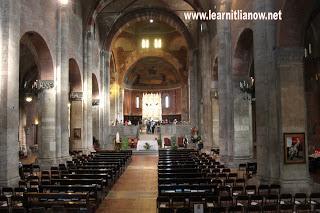
The churc basilica di san Pietro in ciel d'oro
Potete vistarela basilica dalle 7 alle 12 e dalle 15 alle 19 Piazza S. Pietro in Cielo d’oro 2 Paviawww.santagostinopavia.it

